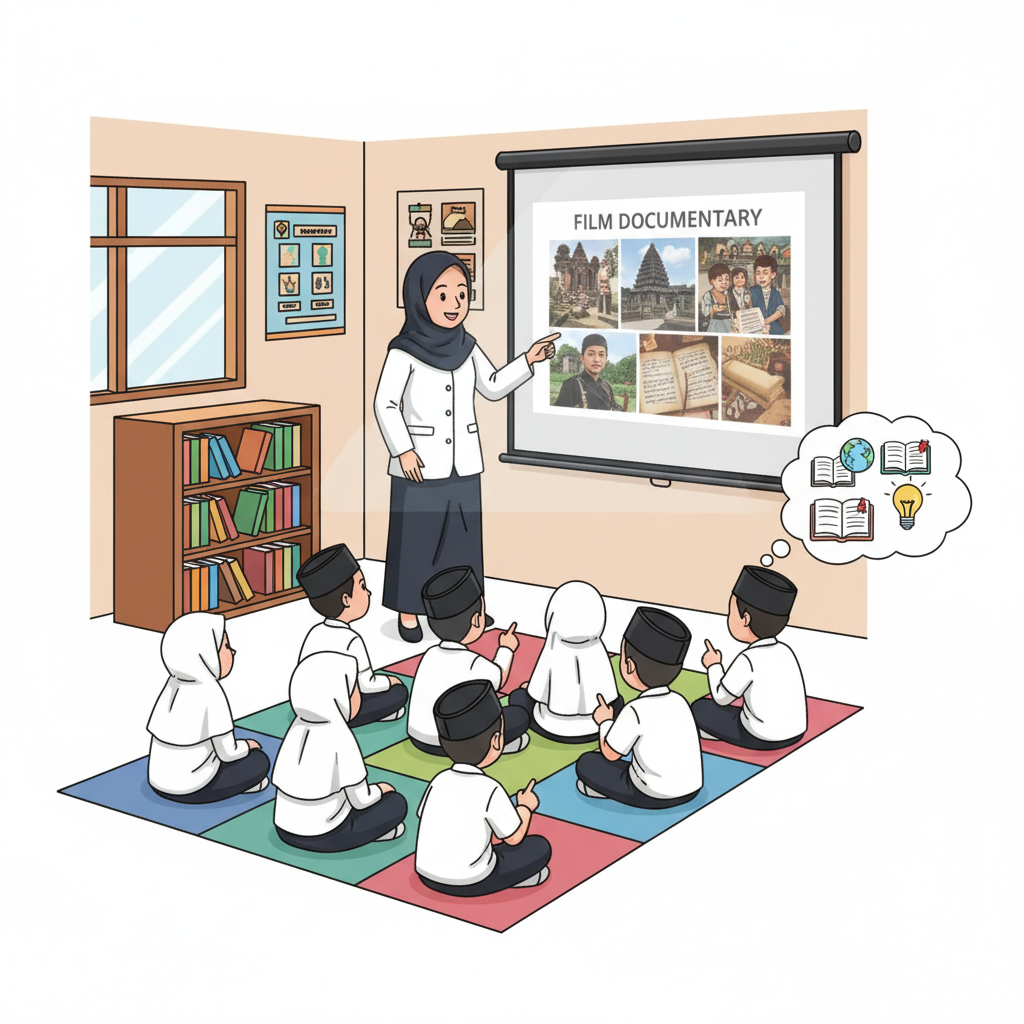Pemanfaatan Film Dokumenter sebagai Pemenuhan Kebutuhan Informasi Sejarah di SD Islam Miftakhul Hikmah
DOI:
https://doi.org/10.53088/librarium.v2i2.885Keywords:
Informasi, film dokumenter sejarah, Documentary Film, History, Learning ResourcesAbstract
Learning history requires new learning methods so that students can properly receive the historical information or knowledge that has been given by the teacher to students. Learning history requires new learning methods because if history subjects are only explained using lectures from teachers, students will get bored. The use of documentary films is a new learning method provided by the Miftakhul Hikmah Islamic Elementary School teacher as a form of learning innovation so that students do not get bored and students can properly receive the information provided by the teacher. Researchers want to examine the usefulness of documentary films as a learning medium. This research uses qualitative research methods to obtain data, with data collection techniques in the form of interviews, observation and documentation. The results of this research are the existence of new learning methods and also how teachers obtain or can assess student abilities by providing evaluations to students.
References
Afrina, C., Bustamin, B., Rasyid, S., Ardyawin, I., Adripen, A., Yendri, R. F., & Khofifah, K. (2021). Educational Film Screening As an Innovation for Padang Panjang City Library Services. Ekspresi Seni : Jurnal Ilmu Pengetahuan Dan Karya Seni, 23(2), 448. https://doi.org/10.26887/ekspresi.v23i2.2063
Aji, A. (2019). Kreativitas Guru Fiqih Dalam Penggunaan Metode Pembelajaran Di Mts Al-Ma’arif Tulungagung. Pendidikan, 84, 65–78. Retrieved from http://repo.iain-tulungagung.ac.id/10276/2/ABSTRAK.pdf
Alfathoni, Mohammad Ali Rosyid & Manesah, D. (2020). Pengantar Teori Film. Sleman: Deepublish.
Firmansyah, H., Putri, A. E., & Maharani, S. (2022). Penggunaan Film Dokumenter sebagai Media Pembelajaran Sejarah. Edukatif : Jurnal Ilmu Pendidikan, 4(2), 2754–2762. https://doi.org/10.31004/edukatif.v4i2.2493
Magdalena, I., Hidayati, N., Dewi, R. H., Septiara, S. W., & Maulida, Z. (2023). Pentingnya Evaluasi dalam Proses Pembelajaran dan Akibat Memanipulasinya. Masaliq, 3(5), 810–823. https://doi.org/10.58578/masaliq.v3i5.1379
Permatasari, A. Y. (2023). BAB II Tinjauan Pustaka BAB II TINJAUAN PUSTAKA 2.1. 1–64. Gastronomía Ecuatoriana y Turismo Local., 1(69), 5–24.
Pettalongi, S. S., Jurusan, D., Stain, T., & Palu, D. (2009). Evaluasi dalam Pendidikan danPembelajaran. Ta’Dieb, 11(6), 1001–1012.
Ratmanto, A. (2018). Gadjah Mada Journal of Humanities, 2(2), 369–392. Retrieved from https://journal.ugm.ac.id/sasdayajournal
Shabrina, S. (2019). Nilai moral Bangsa Jepang Jin dalam Film Sayonara Bokutachi No Youchien. Janaru Saja : Jurnal Program Studi Sastra Jepang, 7(2), 9–30. https://doi.org/10.34010/js.v7i2.2419
Sugiyono. (2018). Metode Penelitian Kuantitatif, Kualitatif dan R&D. Bandung: Alfabeta.
Sukraningsih, J. (2021). Penggunaan Film Dokumenter Sebagai Sumber Belajar Dalam Proses Pembelajaran Ips Sejarah Di Smp Ketapang. Jurnal Kajian Pembelajaran Dan Keilmuan, 5(1), 34. https://doi.org/10.26418/jurnalkpk.v5i1.48735
Wismawarin, B. (2020). Analisis sejarah. International Assosiation For Public Participation, 1. Retrieved from https://iap2.or.id/pembelajaran-daring-di-masa-pandemi-solusi-atau-masalah/
Yasa, D. P. Y. A. T., & Payuyasa, I. N. (2019). Pemanfaatan Film Dokumenter the Cove Sebagai Media Kampanye Penyelamatan Lumba. Gorga : Jurnal Seni Rupa, 8(2), 440. https://doi.org/10.24114/gr.v8i2.16072
Yulianti, N., & Seprina, R. (2022). Pemanfaatan Situs Candi Muaro Jambi Sebagai Sumber Belajar Bagi Mahasiswa Pendidikan Sejarah Universitas Jambi. Krinok: Jurnal Pendidikan Sejarah Dan Sejarah, 1(2), 141–155. https://doi.org/10.22437/krinok.v1i2.18422

Downloads
Published
How to Cite
Issue
Section
License
Copyright (c) 2025 Dinda Muthiara Ayu

This work is licensed under a Creative Commons Attribution-ShareAlike 4.0 International License.
Authors retain copyright and grant the journal the right of first publication with the work simultaneously licensed under a Creative Commons Attribution-ShareAlike 4.0 International License. In line with the license, authors are allowed to share and adapt the material. In addition, the material must be given appropriate credit, provided with a link to the license, and indicated if changes were made. If authors remix, transform, or build upon the material, they must distribute their contributions under the same license as the original.
License details: https://creativecommons.org/licenses/by-sa/4.0/

